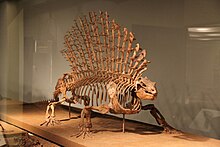| Eupelycosauria Temporal range: Pennsylvanian–Recent, 308–0 Ma PreꞒ Ꞓ O S D C P T J K Pg N Possible Bashkirian records. | |
|---|---|

| |
| Edaphosaurus pogonias skeleton mounted at the Field Museum | |

| |
| Cutleria wilmarthi | |
| Scientific classification | |
| Domain: | Eukaryota |
| Kingdom: | Animalia |
| Phylum: | Chordata |
| Clade: | Synapsida |
| Clade: | Eupelycosauria Kemp, 1982 |
| Subgroups | |
| |
Eupelycosauria is a large clade of animals characterized by the unique shape of their skull, encompassing all mammals and their closest extinct relatives. They first appeared 308 million years ago during the Early Pennsylvanian epoch, with the fossils of Echinerpeton and perhaps an even earlier genus, Protoclepsydrops, representing just one of the many stages in the evolution of mammals, in contrast to their earlier amniote ancestors.
Taxonomy
Eupelycosaurs are synapsids, animals whose skull has a single opening behind the eye. They are distinguished from the Caseasaurian synapsids by having a long, narrow supratemporal bone (instead of one that is as wide as it is long) and a frontal bone with a wider connection to the upper margin of the orbit. The only living descendants of basal eupelycosaurs are the mammals.
The group was originally considered a suborder of pelycosaurs or "mammal like reptiles", but it was redefined in 1997, and the term pelycosaur itself has fallen into disfavor. We now know that the eupelycosaurs were not in fact reptiles nor of reptile lineage - the modern term stem mammal is used instead. Some recent studies suggested that one of its subgroups, Varanopidae, are really nested within sauropsids, leaving the other defined subgroup of it, Metopophora, as its synonym.
Evolution

Many non-therapsid eupelycosaurs were the dominant land animals from the latest Carboniferous to the end of the Early Permian epoch. Ophiacodontids were common from their appearance in the late Carboniferous (Pennsylvanian) to the early Permian, but they became progressively smaller as the early Permian progressed. The edaphosaurids, along with the caseids, were the dominant herbivores in the early part of the Permian. The most renowned edaphosaurid is Edaphosaurus, a large herbivore which had a sail on its back, probably used for thermoregulation and mating. Sphenacodontids, a family of carnivorous eupelycosaurs, included the famous Dimetrodon, which is sometimes mistaken for a dinosaur, and was the largest predator of the period. Like Edaphosaurus, Dimetrodon also had a distinctive sail on its back, and it probably served the same purpose - regulating heat. The varanopid family passingly resembled today's monitor lizards and may have had the same lifestyle.
Therapsids descended from a clade closely related to the sphenacodontids. They became the succeeding dominant land animals for the rest of the Permian, and in the latter part of the Triassic, descendants of the cynodonts, an advanced group of therapsids, gave rise to the first true mammals. All non-therapsid synapsids, including all basal eupelycosaurs, as well as many other life forms, became extinct at the end of Permian period.
Classification
The following cladogram is modified from Huttenlocker et al. (2021):
| Synapsida |
| ||||||||||||||||||||||||||||||||||||||||||||||||||||||||||||||||||||||||||||||||||||||||||||||||||||||||||||||||||
References
- ^ Spindler, F., R. Wernburg, J. W. Schneider, L. Luthardt, V. Annacker, and R. Roßler. 2018. First arboreal ‘pelycosaurs’(Synapsida:Varanopidae) from the early Permian Chemnitz Fossil Lagerstatte, SE-Germany, with a review of varanopid phylogeny. Palaontologische Zeitschrift. doi: 10.1007/s12542-018-0405-9.
- Neil Brocklehurst & Jörg Fröbisch (2018) A reexamination of Milosaurus mccordi, and the evolution of large body size in Carboniferous synapsids, Journal of Vertebrate Paleontology, 38:5, DOI: 10.1080/02724634.2018.1508026
- Kemp. T.S., 1982, Mammal-like Reptiles and the Origin of Mammals. Academic Press, New York
- Laurin, M. and Reisz, R. R., 1997, Autapomorphies of the main clades of synapsids - Tree of Life Web Project
- Reisz, R. R., 1986, Handbuch der Paläoherpetologie – Encyclopedia of Paleoherpetology, Part 17A Pelycosauria Verlag Dr. Friedrich Pfeil, ISBN 3-89937-032-5
- Ford, David P.; Benson, Roger B. J. (2018). "A redescription of Orovenator mayorum (Sauropsida, Diapsida) using high‐resolution μCT, and the consequences for early amniote phylogeny". Papers in Palaeontology. 5 (2): 197–239. doi:10.1002/spp2.1236.
- Modesto, Sean P. (January 2020). "Rooting about reptile relationships". Nature Ecology & Evolution. 4 (1): 10–11. doi:10.1038/s41559-019-1074-0. ISSN 2397-334X. PMID 31900449. S2CID 209672518.
- MacDougall, Mark J.; Modesto, Sean P.; Brocklehurst, Neil; Verrière, Antoine; Reisz, Robert R.; Fröbisch, Jörg (2018). "Commentary: A Reassessment of the Taxonomic Position of Mesosaurs, and a Surprising Phylogeny of Early Amniotes". Frontiers in Earth Science. 6. doi:10.3389/feart.2018.00099. ISSN 2296-6463.
- "Synapsida". Palaeos. Archived from the original on 13 March 2006.
- Huttenlocker, A. K.; Singh, S. A.; Henrici, A. C.; Sumida, S. S. (2021). "A Carboniferous synapsid with caniniform teeth and a reappraisal of mandibular size-shape heterodonty in the origin of mammals". Royal Society Open Science. 8 (12): 211237. Bibcode:2021RSOS....811237H. doi:10.1098/rsos.211237. PMC 8672069. PMID 34925870.
External links
- "Eupelycosauria". Paleos. Archived from the original on May 3, 2006.
- "Main Groups of Non-Mammalian Synapsida". Mikko's Phylogeny Archive. Archived from the original on December 10, 2022.
| Synapsida | |||||||||||||||||||||||||||||||||||
|---|---|---|---|---|---|---|---|---|---|---|---|---|---|---|---|---|---|---|---|---|---|---|---|---|---|---|---|---|---|---|---|---|---|---|---|
| |||||||||||||||||||||||||||||||||||
| |||||||||||||||||||||||||||||||||||
| |||||||||||||||||||||||||||||||||||
| |||||||||||||||||||||||||||||||||||
| |||||||||||||||||||||||||||||||||||
| Taxon identifiers | |
|---|---|
| Eupelycosauria | |





